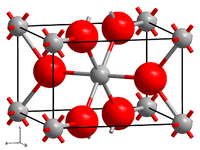Manganese (II) fluoride
| Crystal structure | ||||||||||||||||
|---|---|---|---|---|---|---|---|---|---|---|---|---|---|---|---|---|

|
||||||||||||||||
| __ Mn 2+ __ F - | ||||||||||||||||
| Crystal system |
tetragonal |
|||||||||||||||
| Space group |
P 4 2 / mnm (No. 136) |
|||||||||||||||
| General | ||||||||||||||||
| Surname | Manganese (II) fluoride | |||||||||||||||
| other names |
Manganese difluoride |
|||||||||||||||
| Ratio formula | MnF 2 | |||||||||||||||
| Brief description |
pink solid |
|||||||||||||||
| External identifiers / databases | ||||||||||||||||
|
||||||||||||||||
| properties | ||||||||||||||||
| Molar mass | 92.93 g mol −1 | |||||||||||||||
| Physical state |
firmly |
|||||||||||||||
| density |
3.98 g cm −3 (25 ° C) |
|||||||||||||||
| Melting point |
856 ° C |
|||||||||||||||
| boiling point |
1820 ° C |
|||||||||||||||
| solubility |
slightly soluble in water (10 g l −1 ) |
|||||||||||||||
| safety instructions | ||||||||||||||||
|
||||||||||||||||
| As far as possible and customary, SI units are used. Unless otherwise noted, the data given apply to standard conditions . | ||||||||||||||||
Manganese (II) fluoride is a chemical compound of manganese and is one of the fluorides .
Extraction and presentation
Manganese (II) fluoride can be obtained by reacting manganese carbonate with hydrofluoric acid . It was received in this way by Jöns Jakob Berzelius as early as 1824 .
It can also be displayed directly from the elements.
The tetrahydrate is formed by the slow evaporation of an aqueous solution of manganese (II) fluoride.
properties
Manganese (II) fluoride forms pink square prisms and is sparingly soluble in water, soluble in dilute hydrofluoric acid and slightly soluble in concentrated hydrochloric acid and nitric acid . It is an antiferromagnet and has a tetragonal crystal structure of the rutile type with the space group P 4 2 / mnm (space group no. 136) and the lattice constants a = b = 487.3 pm and c = 313.0 pm. Its Néel temperature is 68 K. The compound forms fluorocomplexes M 1 MnF 3 with a perovskite structure and M 1 MnF 4 with alkali fluorides .
use
Manganese (II) fluoride can be used as a catalyst in pyridine syntheses .
Web links
Individual evidence
- ↑ a b c d Georg Brauer (Ed.), With the collaboration of Marianne Baudler a . a .: Handbook of Preparative Inorganic Chemistry. 3rd, revised edition. Volume I, Ferdinand Enke, Stuttgart 1975, ISBN 3-432-02328-6 , p. 268.
- ↑ a b Z. Yamani, Z. Tun, DH Ryan: Neutron scattering study of the classical antiferromagnet MnF 2 : a perfect hands-on neutron scattering teaching courseSpecial issue on Neutron Scattering in Canada. In: Canadian Journal of Physics. 88, 2010, pp. 771-797, doi : 10.1139 / P10-081 .
- ↑ a b c d e f Data sheet Manganese (II) fluoride, 98% from Sigma-Aldrich , accessed on July 7, 2012 ( PDF ).
- ↑ AMERICAN ELEMENTS: Manganese Fluoride
- ^ A b Leopold Gmelin, Michael Dub, Patrick J. Lennon, Richard Joseph Meyer: Gmelin handbook of inorganic chemistry. Springer, 1977, p. 5 ( limited preview in the Google book search).
- ↑ webelements: WebElements Periodic Table of the Elements | Manganese | chemical reaction data
- ↑ GP Felcher, R. Adhesives: Anti Ferromagnetic domains and the spin-flop transition of MnF2 In: Europhys. Lett. 36, 455 (1996) doi : 10.1209 / epl / i1996-00251-7 .
- ^ AF Holleman , E. Wiberg , N. Wiberg : Textbook of Inorganic Chemistry . 101st edition. Walter de Gruyter, Berlin 1995, ISBN 3-11-012641-9 , p. 1483.
- ↑ S. Shimizu, N. Watanabe, T. Kataoka, T. Shoji, N. Abe, S. Morishita, H. Ichimura: Pyridine and Pyridine Derivatives. In: Ullmann's Encyclopedia of Industrial Chemistry . Wiley-VCH, Weinheim 2005.



